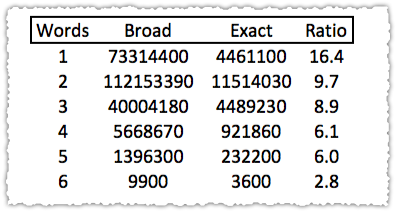That awkward moment when you realize you’ve been staring at interesting data for years without knowing it.

Every day you’re probably using Google Keyword Tool query volume in your SEO research. Of course you have to be careful to use the correct match type, right? You don’t want to make the mistake of promising broad match level volume to a client.
Recently I began to wonder about the differences in match type volume. Because they are substantial.
Keyword Match Ratio
What am I talking about? The keyword match ratio is the broad match volume of a keyword divided by the exact match volume of a keyword.

I know these are completely different keywords but the difference is pretty astounding. This metric should be meaningful. It’s not some end-all-to-be-all metric, but I believe the keyword match ratio is useful.
Here’s how I’ve been looking at and using the keyword match ratio.
Determining Intent
One of the main ways I’ve been using this new metric is in determining intent. Or, more specifically, is the intent uniform or fractured?
A low keyword match ratio indicates a more uniform syntax which often maps to uniform intent. In other words, there aren’t as many keyword variations of that term or topic. Uniform intent is great from a search perspective because you can more easily deliver a relevant and valuable experience for that traffic.
A high keyword match ratio indicates a less uniform syntax which may indicate fractured intent. That means there might be a lot of ways to talk about that topic or could point to a whole modifier class. Fractured intent is more difficult to satisfy since users may come with different expectations of value.
Unfortunately, determining intent got more difficult when Google reduced the level of category detail during the merge of Google Trends and Google Insights for Search.

You can still see that there’s potential fractured intent here but the old version would have presented the various percentage breakdowns for each category which was quite useful. Keyword match ratio provides a new way to validate whether you should be concerned about fractured intent.
Identifying Content Opportunities
The other way I’ve been using the keyword match ratio is to identify areas ripe for content creation. In this case, a high keyword match ratio indicates a potential for different modifiers and phrases for that keyword.

The term ‘hardwood floors’ has a pretty high keyword match ratio and even the suggested ad groups provide ample content ideas. Go a step further and use related searches and Google Autocomplete suggestions to get more ideas that match query syntax.


Look at all those content opportunities! Follow high keyword match ratios to uncover content ideas and opportunities.
Benchmarking
While I can usually just tell whether a keyword match ratio is high or low, or simply compare it to other keywords in a list, I wondered if I could create a benchmark. Enter Dr. Pete, who was kind enough to share the 1,000 keywords that comprise MozCast. (Thank you.)
The first thing I did was see how the keyword match ratio changed with query length.

As you might expect, the ratio declines as the number of words in the query increase. I like when things make sense! What this allows me to do is identify specific keywords that are materially outside of the norm.
What about the 2 word query with a ratio of 226.3 or the 2 word query with a ratio of 2.2. The ratio tells you something about the behavior of that keyword. It’s your job to figure out what it is.
Competition
My next idea was to map the ratio to keyword difficulty. I experimented with using the competition number via the Google Keyword Tool as a proxy but the numbers were all over the place.
So … I generated the keyword difficulty for 92% of the list five painstaking keywords at a time via the SEOmoz Keyword Difficulty Tool. (There’s a 300 a day limit so I didn’t quite get through the entire list.)

There might be a trend there but it was difficult to tell with all the noise. So I rounded keyword difficulty into deciles.

No terms fit into the 0, 10 or 100 deciles so I removed those rows from the table. What’s left does seem to indicate a rising keyword match ratio with increased keyword difficulty. That’s interesting and makes a bit of sense too. Competitive terms often have more volume and likely have a greater number of variants.
Putting It All Together
The question is how you can use all of this information together? To be honest, I haven’t come up with the perfect formula but I find it interesting to take terms and see where they fall against these benchmarks.

What about the term ‘swedish fish’? This 2 word keyword has a keyword match ratio of 3.3, well below the 2 word benchmark. In addition, with a 41% keyword difficulty it falls into the 40 bucket, which again puts it below the standard keyword match ratio for that difficulty.
That tells me the intent behind the term ‘swedish fish’ is uniform and it might be an area where a well optimized piece of content could rank well. Yum!
A term with a low keyword match ratio and low competition is a great SEO opportunity.
The syntax and intent are clear and you can provide relevant and useful content to fill that need. Of course, all of this has to produce productive traffic. We’re not doing SEO just for gold stars and pats on the back, right?

What about a term like ‘solar panels’? It has a keyword match ratio of 13.5, above the 2 word benchmark. With a keyword difficulty of 70% it also scores slightly over the average.
That tells me optimizing for ‘solar panels’ is going to be a hot mess. Instead, I’d want to look for phrases and modifiers that might be more attractive instead, with the long-term goal of building up to this head term.
Locate the specific intents and keywords that contribute to a high keyword match ratio and produce relevant content that satisfies and engages.
Context, Brains and Disclaimers
A couple of things you should know about the keyword match ratio. You need to use it in conjunction with other tools, in particular your brain. Context is important and different verticals and modifiers will have different keyword match ratio patterns.
So while I provide the benchmarks above you should be thinking about how the ratio fits into the keyword universe for your site, or for that particular modifier. If you were a coupon site you might want to see which store + coupons terms had the highest and lowest keyword match ratio.
There’s also the possibility that the set of data I used for the benchmark isn’t representative. However, I think Dr. Pete has done a pretty good job here and while some of the terms are strange and mundane that’s not a bad reflection of reality.
You’ll also note that I’m not doing any heavy duty statistical analysis here. While I understand and enjoy those endeavors I think pattern recognition can take you pretty far pretty quickly. Maybe someone else can pick up this thread and create something more statistically valid.
In the interim, I’m using the keyword match ratio as an SEO hack to help me find potential diamonds in the rough and areas for content creation.
TL;DR
The keyword match ratio measures the ratio of broad match volume and exact match volume. This metric is not fool proof. You need to use your brain when looking at it. But if you’ve got a good head on your shoulders the keyword match ratio can help you determine intent and sniff out content opportunities.
The Next Post: Twitter Will Win The Social Brand Advertising War
The Previous Post: Reading May Influence AuthorRank

7 trackbacks/pingbacks
Comments About Keyword Match Ratio
// 29 comments so far.
John Ellis // October 27th 2012
AJ,
It’s interesting that you are doing this with exact match. I’m a Market Samurai user and in the software you can filter out keywords by (PBR) or phrase to broad match. My understanding of exact match is that it’s too small or to exact. In Market Sam a phrase match of 15% (per their software algo) is indicative of a broad term that is also a phrase match and potentially worth targeting.
These terms are usually longer tail terms (at least 3 words). Once the best group of phrase to broad match terms have been identified, they are again filtered by SEO competition (major on-page factors). If competition is weak, you have a killer term to go after. If strong, you know that particular term is going to be tough to rank for or at least take longer.
Point being… I’ve never considered exact match because of the low search volume. Phrase seems to be the best middle ground.
What are the benefits to targeting exact over phrase.. if any?
~ J
AJ Kohn // October 27th 2012
John,
I should have looked at Market Samurai since they seem to be doing something similar. I could have used phrase match for the ratio and it actually produces similar results. But I find exact match to be more interesting when you’re trying to determine intent and identify different syntax (which is super important.)
Now, in general, I usually use phrase match or a combination of exact and phrase when I’m looking at developing a keyword universe and putting together SEO forecasts or models. I just didn’t use it for this metric.
In fact, a high keyword match ratio pretty much tells you there are a number of interesting phrase match opportunities right around the corner.
Max Minzer // October 27th 2012
So, AJ, ideally (with brains and context of one’s site) your study finds these properties:
– lower ratio corresponds to lower competition
– lower ratio corresponds to larger number of words in the phrase
How about the mix of all this?
Isn’t this the “definition” of long-tail where you’re trying to find the term with smaller number of words in it (and more opportunity available) and least competition?
I tried some of my successful keywords and they were in this “diamond” category. Very interesting!
I need coffee – I feel like I’m looking at a double rainbow…
AJ Kohn // October 27th 2012
Max,
What I generally look for are those terms that have a low keyword ratio and low competition as compared to the benchmark or other keywords in my universe. Those are the ones that you should be able to a) produce really good and optimized content for and b) should be easier to rank for.
You find those terms that will bring highly relevant (focused intent) productive traffic. Sometimes these are long-tail terms but you can even find some gems with two word terms too.
I think it’s just another way of helping to prioritize not by volume but by opportunity.
iKnowSEO // October 27th 2012
This is kind of similar to what SEO Map did a while back: http://www.seomap.com/seo/keyword-strategy/analysis/traffic/long-tail/
Larry Kim // October 29th 2012
interesting read, AJ.
When you say “A term with a low keyword match ratio and low competition is a great SEO opportunity.”
Do you think it would be still OK to substitute “low keyword match ratio” to “high exact match keyword volume estimate” and get a decent approximation?
When it comes to determine if a keyword has Uniform vs. fractured keyword intent, do you think using a phrase match volume estimate be a decent proxy for this?
generally i just look at the phrase match numbers because it’s in the middle. Broad Match is too crazy, exact match is too restrictive.
AJ Kohn // October 29th 2012
Thanks for the kind words and comments Larry.
For me it’s about locating those terms which are focused yet less competitive. Not only does ranking on those terms become easier but the traffic is usually more productive because the intent is clear. So I like putting all of the things together. The metric is interesting but only when paired with other data.
A high keyword match ratio usually points to a number of great phrases hiding in the wings and, yes, they often provide a great proxy for uniform intent. You can actually do the keyword match ratio using phrase and it turns out to be similar. I like using exact because it lets me take root terms and flush out those that have the best chance of generating those uniform intent phrases.
Thoufeeq // October 29th 2012
You created a formulae then 🙂
Awesome post!
Thanks
Rick // October 29th 2012
“That tells me optimizing for ‘xxx’ is going to be a hot mess. Instead, I’d want to look for phrases and modifiers that might be more attractive instead, with the long-term goal of building up to this head term.”
Seems no one ever gets the memo that competitive head terms are not the way to go when starting out. I see this mistake over and over and over, it gets tiring trying to explain the same answer so many times. Even with perfect on page optimization there just aren’t enough quality signals to budge the needle.
AJ Kohn // October 30th 2012
Thanks for the comment Rick. Unfortunately, I see that same mistake time and time again as well.
Too often folks spend time trying to rank for the head term and ignore building up the foundation of long-tail and mid-tail terms. It’s doubly dangerous because you need the trust and authority those long and mid-tail terms can provide over time in order to win (consistently) on a head term.
Steve M // October 30th 2012
Wow. This post nearly slipped past me – even though it was on Inbound.org – but I’m so glad that it didn’t.
Good work, AJ! 🙂 Like you say in the intro, it’s one of those head-smacking moments when you realise that those two figures have been there all this time, and a simple formula can help to reveal so much more.
I like the Long Tail Factor formula in the post iKnowSEO shared as well. It may be a bit excessive/unnecessary but I wonder what one would find while referring to both of them? Might check it out the next time I do full-on keyword research for someone!
AJ Kohn // October 30th 2012
Thanks Steve, I’m glad you found it useful. I think anything you can do to provide actionable insights at the start of the research process is valuable. Please let me know how it works when you do your next round of full-on keyword research.
Darren Sheffield // October 30th 2012
Love the time you have taken on this to add in the other variables etc. Started by reading and thinking straight away…hmmm…what about no of words.
I think this could be really useful, as in the past I’ve made some forecasting errors looking at highly generic, low competition keywords. Incorrecty assumed they would be easy to directly target and then got washed out by all the other content indirectly targeting this keyword.
Nice stuff, love to see an analytical approach. Might not be, and may never be perfect but it gives numbers to make decisions on or explain why you made decisions.
Thanks for sharing
AJ Kohn // October 30th 2012
Thanks Darren. And yes, I don’t think this is the metric, but it’s another tool in the box that you can use to help decide how to best allocate your optimization resources. Glad you found it useful and would love to hear feedback if you apply it to projects.
JN // October 30th 2012
Hi AJ,
This might be a silly question, but is the keyword match ratio by query length an average of your list of keywords? I headed over to MozCast but didn’t see which metric you’re looking at for benchmarking.
Thanks for sharing. Good stuff!
AJ Kohn // October 30th 2012
JN,
Good question.
What I’m doing there is taking the entire list of keywords and getting the exact and broad match volume for each. I then add a word count calculation and column next to those.
At that point I do a sumif statement for each word count length. So it’s summing the exact and broad match volume for any keyword with that word count. Using those totals I then perform the ratio calculation. I do not average the individual ratios per keyword.
We've Got Your Customers // November 04th 2012
Good Read AJ:
Keyword Research is one of the most overlooked and rushed through parts of the optimizations process.
It can also be one of the most devastating since it takes place so early and in most cases a LOT of your sites content is built around it.
We ask all our Clients to provide 10 KW Phrases they think they want to rank well for.
I’d estimate that less than half the time do we use any of these as the Primary Phrase after conducting thorough KW Research up front.
We use the Exact Phrase Search option based on wanting to provide as accurate numbers as possible when setting expectations for clients.
Another commenter mentioned using MS’s metrics. Due to them using the 6 year old data that the #1 spot should get 42% of the clicks, we’ve found this simply not to be true. There are many studies out there and most provide much more conservative estimates of the 1-10 potential for clicks.
Kudos to you for seeking out and sharing more ways to interpret the seemingly less and less data we’re being provided from G!
SEO Scott
AJ Kohn // November 09th 2012
Thanks for the comment Scott.
I do something similar with my clients. I ask for their list of high value keywords up front. As you mention, they frequently aren’t the ones that are most valuable or are simply not the right syntax. But that’s the fun of it all, figuring out how to translate what the client thinks users are looking for into what they really are looking for.
I can’t really comment on Market Samurai since I don’t (and really haven’t past an initial trial) use it. Suffice to say, I generally believe there are other ways to conduct this research using other tools – most importantly your own brain.
Jarl Kubat // November 04th 2012
Thank you for making key word search a bit more clear for me!
Sara Thornton // November 05th 2012
Hi AJ,
Very interesting angle. I do thoroughly enjoy when SEO gets its maths on.
With clients that have dabbled with the AdWords Keyword Tool before contacting us, seeing one word (or two word) phases, low competition and high search volume combos, their eyes often light up. It’s never a nice job to have to burst that bubble and break the news that “unfortunately it’s a little bit more complicated than that”. You’ve illustrated a wonderful way to begin explaining the maths behind why.
Whilst SEO will never be a solely mathematical venture (the human factor will always throw curve balls), it’s nice to see numerical explanations behind “relevance”, which is a win-win for everyone – lower bounce rate, greater conversions, better engagement, and most importantly, happier searchers.
Thanks for providing a nice, quick way of (roughly) measuring the likelihood of keywords being relevant.
AJ Kohn // November 09th 2012
Thanks for the comment Sara.
And yes, many people who dabble likely use the data from the Google Keyword Tool in the wrong way. They look at broad match or global volume instead of local to name just a few. I’m a fan of ways to make the identification and the explanations easier.
I’ve had good luck educating clients using the keyword match ratio.
Andre Buxey // November 09th 2012
Could i say that i really enjoyed the post, however i would stay away from Market Samurai, the only thing i used Market Samurai for was rankings checks and when they switched to cloud rankings came in once a week, which did not suit my needs and i switched to Micrositemaster and been happy ever since. Google Adwords Keyword tool is a good source, why get your water from the tap when you have the source right there?
Thanks for the post as i now have some great content suggestions to look into, never really thought about that right until now and im pleased that i came across your post.
Josh Squires // November 27th 2012
Fantastic article and extremely helpful. I’d been looking for a use for this for a while now. I understood that it had to be of some use, but it wasn’t clear to me. Oddly enough, I found this article right at a time when I really needed the information and it has helped me immensely on my current project.
Patrick // December 04th 2012
Just came across this and love the idea behind it!
My question is what ratio ranges can we use to determine keyword difficulty without using the Moz Keyword Difficulty tool?
Would I just assume that based on the rations given that say any ratio of 1.9 to 3.6 would fall into the “10” keyword difficulty and so on up the scale?
Not sure if that makes any sense 🙂
Warren Lee // December 12th 2012
Am surprised others haven’t called out how this could apply to paid search. I think this metric has some great practical application in paid search. For example, It can be used against your list of paid broad keywords to sort them to help your paid search analyst prioritize which keywords have highest chances of needing more negative match expansion.
Avadhut // February 18th 2013
Hi AJ,
That’s a very useful research and analysis on keywords.
May I know the benchmarks mentioned above are universal and applicable to all sectors?
Secondly, how can we check keyword difficulty if we are not using SEOmoz keyword difficulty tool. Any suggestions?
Regards,
Avadhut
AJ Kohn // March 06th 2013
Avadhut,
The benchmarks are not universal. The best thing to do would be to look at each sector or vertical and see how keywords deviate from a norm. In a pinch what I have here (based on the Mozcast terms) is probably good for general steering.
As for keyword difficulty, I’m not sure there are any other tools out there doing this now. There used to be but … fewer and fewer now.
John // March 06th 2013
Avadhut,
Jumping in here.. I’m a keyword research nerd and use Market Samurai for most of my work. The program is affordable and the best keyword research tool out there IMHO.
The SEO competition matrix gives you the data you need to really determine the level of competition based on all the core SEO factors. The software is maintained and the support is excellent.
A new service called WebMeUp is looking pretty good right now as well. A lot like MOZ in terms of abilities with what I think is a much better UI.
SPYFU is also OK for researching difficulty. But the results are cached.
All are paid programs… I have never seen a free tool that actually gives you what you need to do research right. It is worth the expense to get useful data. Google’s free tool is free for a reason.. they make more money this way.
Just a few suggestions.
Hey AJ..
John
OJogos // August 22nd 2013
Hello, I wanted to ask, now that Ad-words Keyword Tool is no longer operative, and the new Keyword Planner only shows exact match, how do you go about calculating the keyword match ratio?
Very useful post by the way 🙂
Thanks!
Sorry, comments for this entry are closed at this time.
You can follow any responses to this entry via its RSS comments feed.